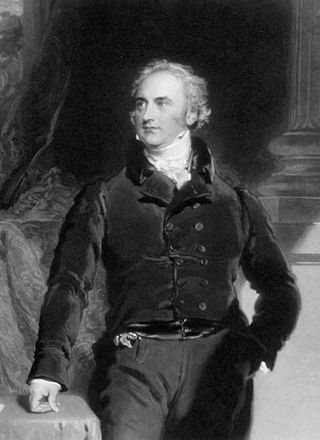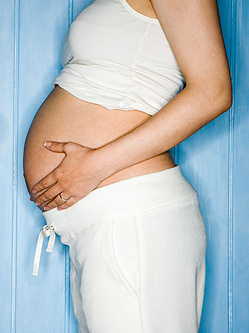
The breast is one of two prominences located on the upper ventral region of a primate's torso. Both females and males develop breasts from the same embryological tissues.

The nipple is a raised region of tissue on the surface of the breast from which, in females, milk leaves the breast through the lactiferous ducts to breastfeed an infant. The milk can flow through the nipple passively or it can be ejected by smooth muscle contractions that occur along with the ductal system. Male mammals also have nipples but without the same level of function, and often surrounded by body hair.

The pubic symphysis is a secondary cartilaginous joint between the left and right superior rami of the pubis of the hip bones. It is in front of and below the urinary bladder. In males, the suspensory ligament of the penis attaches to the pubic symphysis. In females, the pubic symphysis is close to the clitoris. In most adults it can be moved roughly 2 mm and with 1 degree rotation. This increases for women at the time of childbirth.

A fascia is a generic term for macroscopic membranous bodily structures. Fasciae are classified as superficial, visceral or deep, and further designated according to their anatomical location.

Reduction mammoplasty is the plastic surgery procedure for reducing the size of large breasts. In a breast reduction surgery for re-establishing a functional bust that is proportionate to the patient's body, the critical corrective consideration is the tissue viability of the nipple–areola complex (NAC), to ensure the functional sensitivity and lactational capability of the breasts. The indications for breast reduction surgery are three-fold – physical, aesthetic, and psychological – the restoration of the bust, of the patient's self-image, and of the patient's mental health.

The axilla is the area on the human body directly under the shoulder joint. It includes the axillary space, an anatomical space within the shoulder girdle between the arm and the thoracic cage, bounded superiorly by the imaginary plane between the superior borders of the first rib, clavicle and scapula, medially by the serratus anterior muscle and thoracolumbar fascia, anteriorly by the pectoral muscles and posteriorly by the subscapularis, teres major and latissimus dorsi muscle.

The sacroiliac joint or SI joint (SIJ) is the joint between the sacrum and the ilium bones of the pelvis, which are connected by strong ligaments. In humans, the sacrum supports the spine and is supported in turn by an ilium on each side. The joint is strong, supporting the entire weight of the upper body. It is a synovial plane joint with irregular elevations and depressions that produce interlocking of the two bones. The human body has two sacroiliac joints, one on the left and one on the right, that often match each other but are highly variable from person to person.

A nursing bra is a specialized brassiere that provides additional support to women who are lactating and permits comfortable breastfeeding without the need to remove the bra. This is accomplished by specially designed bra cups that include flaps which can be opened with one hand to expose the nipple. The flap is usually held closed with a simple clasp or hook.

Sir Astley Paston Cooper, 1st Baronet was a British surgeon and anatomist, who made contributions to otology, vascular surgery, the anatomy and pathology of the mammary glands and testicles, and the pathology and surgery of hernia.

An inverted nipple is a condition where the nipple, instead of pointing outward, is retracted into the breast. In some cases, the nipple will be temporarily protruded if stimulated. Both women and men can have inverted nipples.

The intermammary cleft, intermammary sulcus, or sulcus intermammarius is a surface feature of males and females that marks the division of the two breasts with the sternum (breastbone) in the middle. The International Federation of Associations of Anatomists (IFAA) uses the terms "sulcus intermammarius" or "intermammary cleft" when referring to the area between the breasts.

Breast hypertrophy is a rare medical condition of the breast connective tissues in which the breasts become excessively large. The condition is often divided based on the severity into two types, macromastia and gigantomastia. Hypertrophy of the breast tissues may be caused by increased histologic sensitivity to certain hormones such as female sex hormones, prolactin, and growth factors. Breast hypertrophy is a benign progressive enlargement, which can occur in both breasts (bilateral) or only in one breast (unilateral). It was first scientifically described in 1648.
Mastopexy is the plastic surgery mammoplasty procedure for raising sagging breasts upon the chest of the woman, by changing and modifying the size, contour, and elevation of the breasts. In a breast-lift surgery to re-establish an aesthetically proportionate bust for the woman, the critical corrective consideration is the tissue viability of the nipple-areola complex (NAC), to ensure the functional sensitivity of the breasts for lactation and breast-feeding.

Ptosis or sagging of the female breast is a natural consequence of aging. The rate at which a woman's breasts drop and the degree of ptosis depends on many factors. The key factors influencing breast ptosis over a woman's lifetime are cigarette smoking, her number of pregnancies, higher body mass index, larger bra cup size, and significant weight change. Post-menopausal women or people with collagen deficiencies may experience increased ptosis due to a loss of skin elasticity. Many women and medical professionals mistakenly believe that breastfeeding increases sagging. It is also commonly believed that the breast itself offers insufficient support and that wearing a bra prevents sagging, which has not been found to be true.

Breast prostheses are breast forms intended to look like breasts. They are often used temporarily or permanently by women after mastectomy or lumpectomy procedures, but may also be used by for aesthetic purposes. There are a number of materials and designs; although, the most common construction is gel in a plastic film meant to feel similar to a person's skin. Prostheses may be purchased at a surgical supply store, pharmacy, custom lingerie shop, or even through private services that come to a person's home. There are many types of ready made breast prostheses including full or standard prostheses, partial prostheses such a shell prostheses, and stick on prostheses. Customized options are also available from specialty shops, which are moulded to fit an individual's chest by taking an impression of the breast(s). The areola and nipple may be replicated as part of the breast form or as separate nipple prosthesis. Both custom made and off-the shelf breast prostheses come in varieties that are designed to either be held in a pocket in a specially designed mastectomy bra or attached to the skin via adhesive or other methods and worn with a standard bra. There are many factors to consider when selecting breast prostheses such as different types and the care they require, insurance coverage, and psychosocial effects.
A bra, short for brassiere or brassière, is a form-fitting undergarment that is primarily used to support and cover a woman's breasts. A typical bra consists of a chest band that wraps around the torso, supporting two breast cups that are held in place by shoulder straps. A bra usually fastens in the back, using a hook and eye fastener, although bras are available in a large range of styles and sizes, including front-fastening and backless designs. Some bras are designed for specific functions, such as nursing bras to facilitate breastfeeding or sports bras to minimize discomfort during exercise.

The following outline is provided as an overview of and topical guide to human anatomy:

Maternal physiological changes in pregnancy are the adaptations that take place during pregnancy that enable the accommodation of the developing embryo and fetus. These are normal physiological adaptations that cause changes in behavior, the functioning of the heart, blood vessels, and blood, metabolism including increases in blood sugar levels, kidney function, posture, and breathing. During pregnancy numerous hormones and proteins are secreted that also have a broad range of effects.
The pencil test is an informal test of breast development and the need to wear a bra. It was published in a 1971 advice column by Ann Landers mostly containing reader responses, pro and anti-bra, to her recent column "berating the braless female who shamelessly bounced and flopped and went shopping ... [which for Landers] created a deluge of mail". One Chicago correspondent chimed in:
The question "to bra or not to bra” can be easily answered if the undecided woman will apply this test to herself. Take an ordinary woodcase pencil. Put it under one breast. If the pencil stays there you should wear a bra. If it falls, you can go braless.

In Western society, since the 1960s, there has been a slow but steady trend towards bralessness among a number of women, especially millennials, who have expressed opposition to and are giving up wearing bras. In 2016, Allure magazine fashion director Rachael Wang wrote, "Going braless is as old as feminism, but it seems to be bubbling to the surface more recently as a direct response to Third Wave moments like #freethenipple hashtag campaign, increased trans-visibility like Caitlyn Jenner's Vanity Fair cover ... and Lena Dunham's show Girls."


















